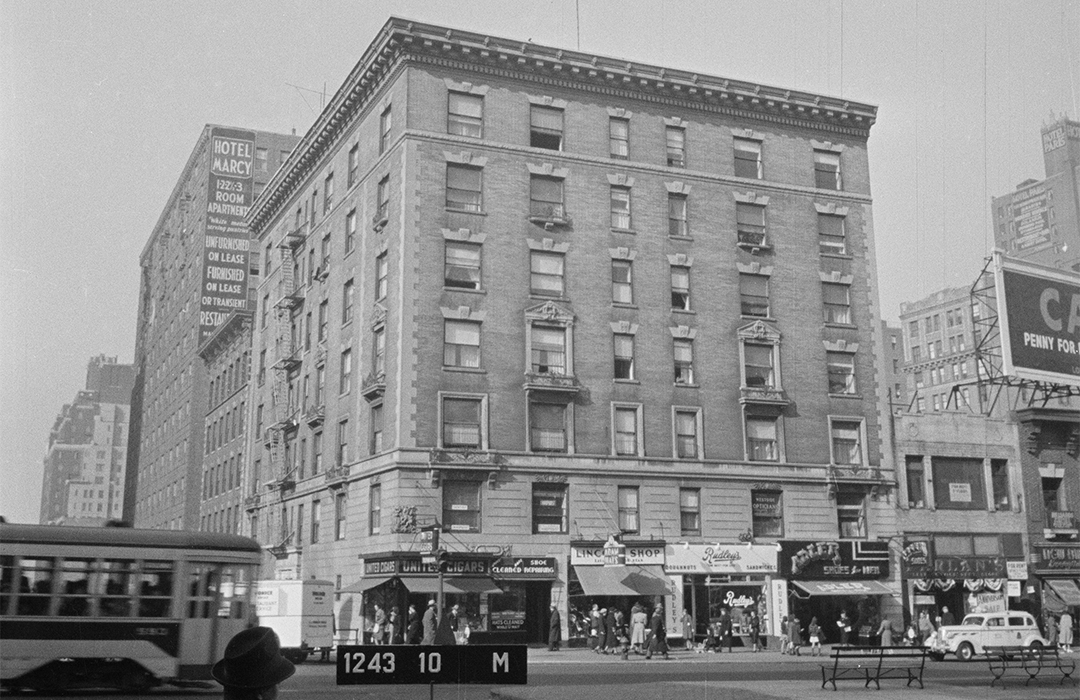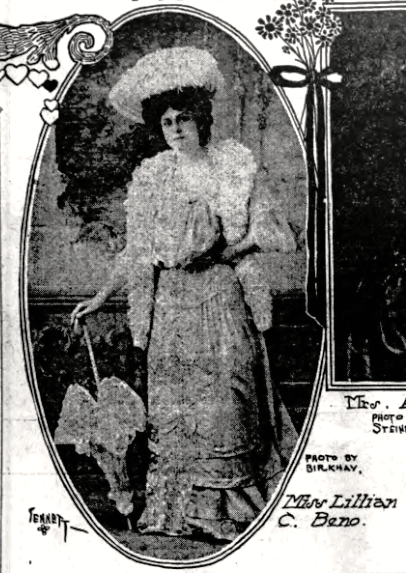
The Tuileries
by Tom Miller
In 1898 real estate developer hired architect T. Reinhardt to design an apartment building on the northwest corner of the Boulevard (renamed Broadway around two years later) and 95th Street. Reinhardt’s plans, filed in January 1899, called for a seven-story “brick and limestone apartment house.” The completed structure, called The Tuileries, was faced in beige Roman brick above a two-story rusticated limestone base. Reinhardt tempered his overall Renaissance Revival design with touches of Beaux-Arts in the florid French-style cast iron balcony railings scattered around the façade.
The eight-room apartments became home to financially comfortable families, like stockbroker George E. Hopple and his wife; musical instrument dealer Victor S. Fletcher; and retired banker Moses S. Hyman. Along the Broadway side were shops.
George E. Hopple’s brokerage office was at 52 Broadway. Directly across the street at 53 Broadway, two of his wife’s brothers, Alfred and John Kelsey, ran a brokerage office, as well. The New York Times said Mrs. Hopple was John Kelsey’s “favorite sister.” (The siblings came from a Philadelphia family of seven children.) John lived in Brooklyn. On the morning of November 15, 1901, instead of going to the office, he rode the train to the Hopple apartment. Once inside, according to The New York Times, he went “straight to her bedroom. He called her to him, and as she entered drew the fatal bottle from his pocket.” The “fatal bottle” contained carbolic acid. John declared, “I’m going to end it all.”
“’Oh, don’t, John,’ she cried, and, springing at him, seized the phial. They struggled for it, and some of the acid burned her hands severely,” reported the article. At that point John was able to wrest the bottle from her grasp and swallow what was left. “Both fell shrieking to the floor.” Mrs. Hopple rushed for help, but when Dr. Elmer Ellsworth Cary arrived after only a few minutes, Kelsey was dead. George Hopple told a reporter that his brother-in-law “had killed himself in his house through a desire to die in his sister’s arms.”
Once inside, according to The New York Times, he went “straight to her bedroom. He called her to him, and as she entered drew the fatal bottle from his pocket.” The “fatal bottle” contained carbolic acid. John declared, “I’m going to end it all.”
Expectedly, the names of the female residents of The Tuileries appeared in society pages routinely. Such was the case on January 19, 1902, when the New York Herald reported, “Mrs. Howard Alencen McLean, of No. 251 West Ninety-fifth street, a few evenings since, entertained a large number of her West End friends at hearts.” And on April 9, 1905, the same newspaper noted, “Miss Lillian C. Beno…who is popular among the younger set, has entertained a great deal this season at luncheons and theatre parties.”
Beginning in the World War I years, newspaperman and short story writer Alfred Damon Runyon and his family lived in The Tuileries. He had married society reporter Ellen M. Egan in 1911. The couple had a daughter, Mary Elaine. While living here, Runyon covered sports for the Hearst newspapers (dropping his first name professionally). On July 17, 1918, the Runyon’s son, Alfred Damon Runyon, Jr. was born in the apartment.
The Runyons had a houseguest, in October 1921. Fifty-year-old Esther Hernandez was visiting from California. On the afternoon of October 7, she took the Runyon children to Riverside Park. Mary was now seven years old, and Damon was three. As they were crossing Riverside Drive, Mrs. Hernandez saw an automobile speeding toward them. The New York Herald reported that she pushed Damon to safety and Mary was able to run to the curb. Esther Hernandez, however, was struck. She was taken to the home of a doctor on Riverside Drive, and later back to the Damon apartment, where her condition was said to be serious. (Following Damon Runyon’s death in 1946, his body was cremated, and famed pilot Eddy Rickenbacker scattered his ashes over Broadway from a DC-3 airplane.)
Living in The Tuileries in 1918 was Caroline Lewis, a thoroughly modern young woman. On April 12 that year, attorney and former assemblyman Louis Cohen took her to court. The headline in the New-York Tribune read, “Woman Sued as Jilt,” and explained Cohen wanted $25,000 in damages “for his wounded feelings,” and another $3,000 “which he says he spent in entertaining Miss Lewis while he believed himself engaged to her.” Caroline Lewis had managed to string him along since she accepted his first proposal in August 1915.
In 1919, three of the Broadway shops were occupied by the Harmon Specialty Shop, in 2541; Domingo F. Evia’s dress shop in 2543; and the Gristede Brothers grocery store in 2547. The Dorien Dress Shop took over the Evia space in 1921.
By then the eight-room apartments rented for between $2,000 and $2,400 per year—about $3,250 per month today for the more expensive. The tenants continued to be professionals, like civil engineer Gustave Kaufman, who oversaw the construction of the Brooklyn anchorage of the Manhattan Bridge.
In 1924 60-year-old John Jacobson was the superintendent of The Tuileries. That year he nearly fell victim to scam artists hard to fathom today—gypsies. On September 12, according to The Newtown Register, four detectives—Dwyer, Barrett, Cronin and Bogan—were searching for two gypsy sisters, Nina and Ann George “as a result of complaints made by people who are alleged to have been victimized.” They spotted to pair talking to Jacobson on West 95th Street. When they separated, the detectives spoke to Jacobson, who admitted he was on the way to the bank to withdraw his life’s savings. The sisters, who were 24 and 25 years old, promised that if they blessed the cash, he would be rewarded with good fortune.
That year he nearly fell victim to scam artists hard to fathom today—gypsies.
Jacobson was told to follow the women’s instructions. He took $1,680 from his bank (nearly $27,000 in today’s money) and waited for them to call at his apartment. When Ann George arrived, he handed her the wrapped stack of bills, including a marked $5 bill. The Newtown Register said she “sent Jacobson out of the room ‘while she blessed the money.’ When he returned, she handed him the wrapped package. As she prepared to leave, the detectives stepped out of hiding and arrested her, while taking Jacobson’s savings from her pocket.
Living here by 1934 was Mary Turner. On the morning of January 25, 1935, The Tuileries super, Charles Sargent went outside to clear the snow and ice and found the body of the 28-year-old on the sidewalk. No one in the building knew anything about her, and police could only say she had either jumped or fallen from her fourth-floor window.
An even more bizarre incident involved 30-year-old Thomas Varden. On August 30, 1937, an anonymous telephone call to police reported a corpse in the rear yard of a rooming house at 9 West 84th Street. The body was that of Varden. The New York Post reported, “Detectives were unable to determine whether the man fell or jumped to his death or whether his body was dumped there.”
In 1941 the once proud apartment house was divided into Single Room Occupancy accommodations—20 rooms per floor. In a case of déjà vu, on September 29, 1975, The New York Times reported, “An unidentified woman in her 20’s was found dead in the rear courtyard of a building at 251 West 95th Street. The police said the woman either was pushed or had fallen from the roof.”
A renovation completed in 1994 began to return the building to apartments. There were still eight S.R.O. rooms on the seventh floor, apparently for previous long-term residents. Three years later the entire building had been renovated to apartments, and in 2006 the vintage building began the process of cooperative conversion. The 122-year-old building has come full circle.
Tom Miller is a social historian and blogger at daytoninmanhattan.blogspot.com
Building Database
Keep Exploring
Be a part of history!
Think Local First to support the businesses and currently at 2541-2547 Broadway
Meet Aida and Vinz Z.!
Meet Kim Duncan and Bretton May!




